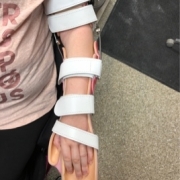Upper Extremity
Shoulder Orthosis (SO)
Shoulder orthoses are commonly used for support and stability to promote healing and/or reduce pain. Various types of shoulder orthoses include but are not limited to; a sling, airplane splint, figure 8 clavicle braces, and abduction restraints.
These devices are commonly used by individuals with:
- Soft tissue and nerve injuries (ex. rotator cuff tears)
- Subluxation and dislocations
- Post-surgical trauma
Elbow Orthosis (EO)
Elbow orthoses may be used to aid in or resist elbow flexion and extension. EOs may also be used for positioning, support and stabilization or to provide a progressive stretch.
These devices are commonly used for individuals with:
- Soft tissue injuries including ligamentous laxities
- Post-surgical
- Conditions that result in self-harm
- Conditions that require contracture management
- Rhett Syndrome
Elbow Wrist Hand Orthosis (EWHO)
Similiar to elbow orthoses, these braces are used to either assist or prevent flexion of the elbow, wrist and hand. These devices aid in contracture management by preventing range of motion loss and maintaining a constant stretch across the elbow, wrist, and hand joints. EWHFOs may have joints at the elbow or wrist to allow for adjustments. In addition, these orthoses may be fabricated to allow detachable wrist and hand extensions.
These devices may be suitable for individuals with:
- Cerebral Palsy (CP)
- Stroke
- Multiple Sclerosis (MS)
- Traumatic brain injury
- Spinal cord injury
- Conditions that require contracture management
Wrist Hand Orthosis (WHO)
A WHO encompasses the forearm and the palm. This orthosis is primarily used to immobilize and support weak muscles or limit wrist motion, but still allowing the fingers to move. For additional support, a bivalve design can be incorporated.
These devices are used for individuals with:
- Osteoarthritis
- Rheumatoid arthritis
- Carpal Tunnel Syndrome
- Ligamentous injury to wrist
- Radial nerve palsy
Hand Orthosis (HO)
Hand and thumb splints are devices that either immobilize or correct the position of one or more fingers for functional activities. These devices can be custom made, custom fabricated or off the shelf.
A thumb spica immobilizes the thumb while allowing the wrist and fingers to move. It is commonly used for patients with osteoarthritis, rheumatoid arthritis, ligamentous injuries to the thumb, post-surgical treatment or De Quervain’s Tenosynovitis.
Finger orthoses align the joints of fingers to promote healing, prevent progression of deformity and increase function. These are commonly used for patients with rheumatoid arthritis, swan neck deformity, boutonniere deformity or mallet finger.
Resources
Click to access Resources




